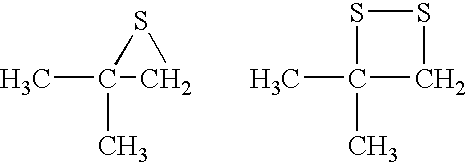Process for removing mercury from liquid hydrocarbons
a liquid hydrocarbon and mercury technology, applied in the petroleum industry, non-metal refining, petroleum processing, etc., can solve the problems of difficult separation of oil-water emulsion, high cost of adsorbent, and difficulty in removing mercury from liquid hydrocarbons
- Summary
- Abstract
- Description
- Claims
- Application Information
AI Technical Summary
Benefits of technology
Problems solved by technology
Method used
Image
Examples
example 2
A relatively fresh sample of a 500.degree. API crude oil was passed under nitrogen pressure through 3.0 micron filter paper, and 100 cc of the resultant filtrate was mixed in a glass container under a nitrogen atmosphere with 0.02 cc of a 5 weight percent unbuffered (pH greater than 10) aqueous solution of sodium sulfide (Na.sub.2 S). The volume ratio of sodium sulfide solution to filtered crude oil was 0.0002. The treated oil from the glass container was then passed through another 3.0 micron filter, and the filtrate was analyzed for mercury. This procedure was repeated using 0.2 cc of a 0.5 weight percent buffered aqueous solution of sodium sulfide having a pH of 8.5. The volume ratio of sodium sulfide solution to filtered crude oil was 0.002. In each case the treat rate of sodium sulfide was 10 ppmw. The results of these tests are set forth below in Table 2.
Like the data in Table 1, the data in Table 2 show that an initial particulate removal step substantially reduces (74%) the ...
example 3
A sample of the 500.degree. API crude oil used in Example 1 was allowed to age for about 4 months. A mercury species analysis showed that approximately 50 percent of the mercury in the oil was in the ionic form. The sample was heated to 50.degree. C. and passed under nitrogen pressure through 3.0 micron filter paper. The filtrate was analyzed for mercury three times and the results were averaged. The concentration of mercury in the crude oil was reduced by the filtration from 2200 ppbw to 1312 ppbw. About 200 cc of the filtered oil was mixed at 50.degree. C. in a nitrogen-flushed glass container with a much smaller amount (about 0.1 cc) of two different treating agents that comprised an organic compound containing a sulfur atom that is reactive with mercury. The resultant mixture was stirred for 10 minutes in the glass container and then passed through a 3 mm thick bed of diatomite (Celatom FW-12) to filter out particulates having diameters of 0.7 microns and above. The diatomite wa...
example 4
A fresh sample of 55.degree. API natural gas condensate containing 588 ppbw mercury, all in the elemental form, was passed at ambient temperature through a 3 mm thick bed of diatomite supported on an 18 micron stainless steel filter screen contained in a stainless steel filter housing. The diatomite (Celatom FW-12) was sized to filter out particles having diameters of 0.7 microns or larger. The filtered oil was analyzed and found to contain 367 ppbw mercury. The filtered oil was then mixed at ambient temperature in a nitrogen-flushed glass container with very small amounts of the same treating agents used in Example 3. The resultant mixture was stirred for 30 minutes in the glass container and then passed through a fresh 3 mm thick bed of diatomite (Celatom FW-12) to again filter out particulates having diameters of 0.7 microns and above. The diatomite was supported on an 18 micron stainless steel filter screen contained in a stainless steel filter housing. The resultant filtrate wa...
PUM
 Login to View More
Login to View More Abstract
Description
Claims
Application Information
 Login to View More
Login to View More - R&D
- Intellectual Property
- Life Sciences
- Materials
- Tech Scout
- Unparalleled Data Quality
- Higher Quality Content
- 60% Fewer Hallucinations
Browse by: Latest US Patents, China's latest patents, Technical Efficacy Thesaurus, Application Domain, Technology Topic, Popular Technical Reports.
© 2025 PatSnap. All rights reserved.Legal|Privacy policy|Modern Slavery Act Transparency Statement|Sitemap|About US| Contact US: help@patsnap.com



